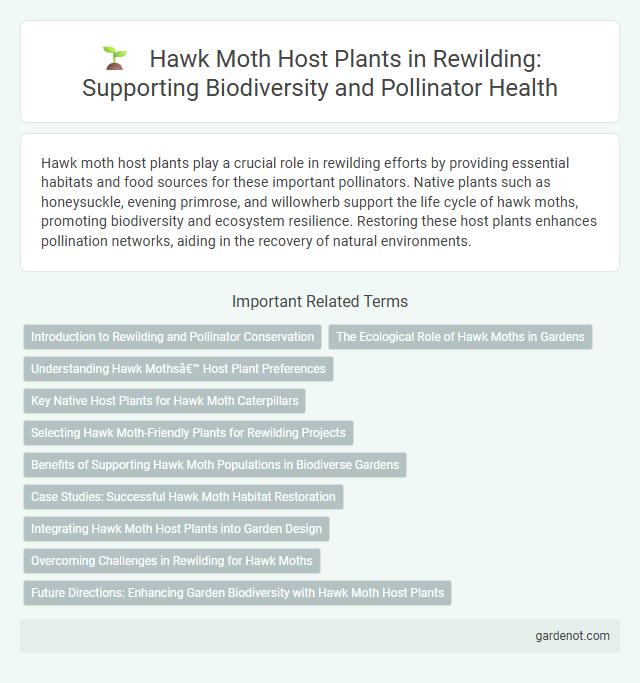Hawk moth host plants play a crucial role in rewilding efforts by providing essential habitats and food sources for these important pollinators. Native plants such as honeysuckle, evening primrose, and willowherb support the life cycle of hawk moths, promoting biodiversity and ecosystem resilience. Restoring these host plants enhances pollination networks, aiding in the recovery of natural environments.
Introduction to Rewilding and Pollinator Conservation
Hawk moths rely heavily on native host plants such as evening primrose and honeysuckle, which support their life cycles and enable effective pollination. Rewilding efforts prioritize the restoration of these crucial plant species to enhance habitat connectivity and promote biodiversity. Conserving pollinator populations like hawk moths supports resilient ecosystems and sustainable natural landscapes.
The Ecological Role of Hawk Moths in Gardens
Hawk moths play a vital ecological role in gardens by serving as key pollinators for numerous native and exotic plants. Their larvae depend on specific host plants, such as bedstraw, willowherb, and honeysuckle, which help sustain local biodiversity and support healthy ecosystems. By facilitating cross-pollination, hawk moths enhance plant reproduction and contribute to the resilience and beauty of rewilded garden habitats.
Understanding Hawk Moths’ Host Plant Preferences
Hawk moths predominantly select host plants from families such as Rubiaceae, Solanaceae, and Onagraceae, which provide optimal larval nutrition and chemical compounds essential for their development. Research indicates that larval survival rates and growth are highest when feeding on native host plants like bedstraw (Galium spp.) and evening primrose (Oenothera spp.), emphasizing the moths' evolved specialization. Understanding these host plant preferences is crucial for rewilding projects aiming to restore hawk moth populations and enhance local biodiversity.
Key Native Host Plants for Hawk Moth Caterpillars
Key native host plants for hawk moth caterpillars include species from the genus *Lonicera* (honeysuckle), *Datura* (jimsonweed), and *Cuscuta* (dodder). These plants provide essential nutrients and habitat for larval development, promoting successful metamorphosis into adult moths. Protecting and restoring these native plants supports biodiversity and strengthens ecosystems where hawk moths play vital pollination roles.
Selecting Hawk Moth-Friendly Plants for Rewilding Projects
Selecting hawk moth-friendly plants for rewilding projects enhances biodiversity by providing essential host plants such as willowherbs (Epilobium spp.) and bedstraws (Galium spp.). These native plants support the caterpillars' lifecycle, ensuring successful breeding and population growth. Incorporating diverse flowering species like honeysuckle (Lonicera periclymenum) also supplies nectar sources critical for adult hawk moths' energy needs.
Benefits of Supporting Hawk Moth Populations in Biodiverse Gardens
Supporting hawk moth populations in biodiverse gardens enhances pollination for night-blooming plants, boosting reproductive success and plant diversity. These moths act as key indicators of ecosystem health, promoting natural pest control by supporting predator-prey food webs. Incorporating native host plants like honeysuckle and evening primrose fosters habitat restoration and strengthens local biodiversity resilience.
Case Studies: Successful Hawk Moth Habitat Restoration
Case studies of hawk moth habitat restoration highlight the critical role of planting native host species such as bedstraw (Galium spp.) and honeysuckle (Lonicera spp.), which support larval development and adult nectar feeding. Restoration projects in the UK and California have documented increased hawk moth populations following the reintroduction of these key plants, demonstrating improved biodiversity and ecosystem resilience. These successful efforts emphasize the importance of targeted native flora reestablishment in rewilding initiatives to sustain specialized pollinators like hawk moths.
Integrating Hawk Moth Host Plants into Garden Design
Integrating hawk moth host plants such as evening primrose (Oenothera spp.) and moonflower (Ipomoea alba) into garden design supports local biodiversity by providing essential nectar sources and larval food for hawk moths. Planting native species like bedstraw (Galium spp.) enhances habitat connectivity and promotes pollination, benefiting overall ecosystem health. Strategic placement of these plants in sunny, well-drained areas increases attractiveness to hawk moths while complementing ornamental garden aesthetics.
Overcoming Challenges in Rewilding for Hawk Moths
Hawk moth rewilding faces significant challenges due to the specific host plants required for larval development, such as certain species of bedstraw (Galium) and willowherb (Epilobium). Ensuring the successful growth and distribution of these native host plants is critical for supporting hawk moth populations and maintaining ecosystem balance. Habitat restoration efforts must prioritize soil quality, vegetation diversity, and protection from invasive species to overcome barriers to effective rewilding.
Future Directions: Enhancing Garden Biodiversity with Hawk Moth Host Plants
Incorporating diverse hawk moth host plants such as willowherb (Epilobium spp.), bedstraw (Galium spp.), and honeysuckle (Lonicera spp.) into garden ecosystems boosts pollinator populations and supports nocturnal biodiversity. Future rewilding projects should prioritize native plants that cater to specific hawk moth larvae species like the five-spotted or hummingbird hawk moth to ensure habitat connectivity and resilience. Optimizing garden layouts with layered vegetation structures enhances microhabitats, improving larval survival rates and fostering long-term ecosystem stability.
Hawk moth host plant Infographic

 gardenot.com
gardenot.com